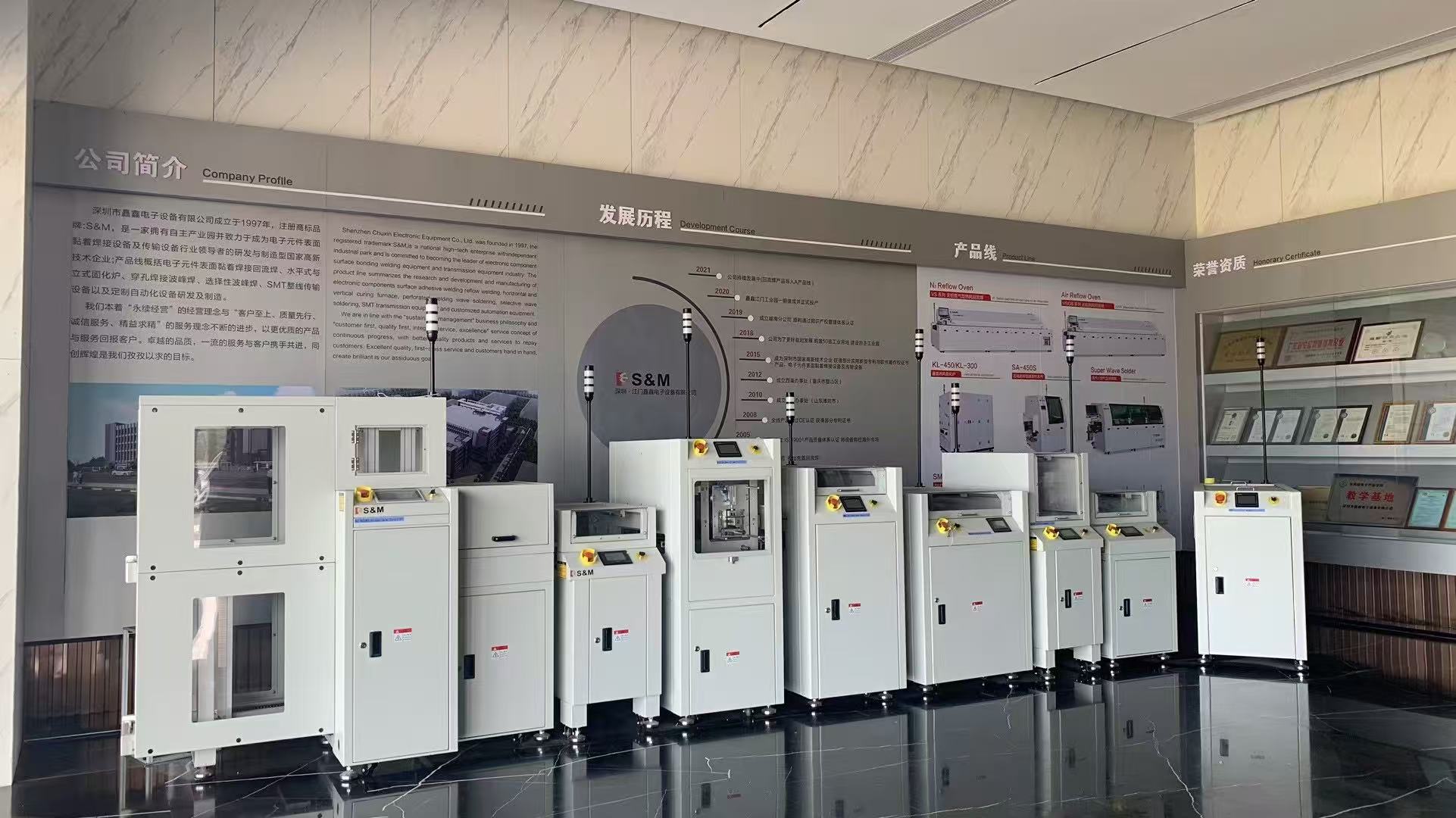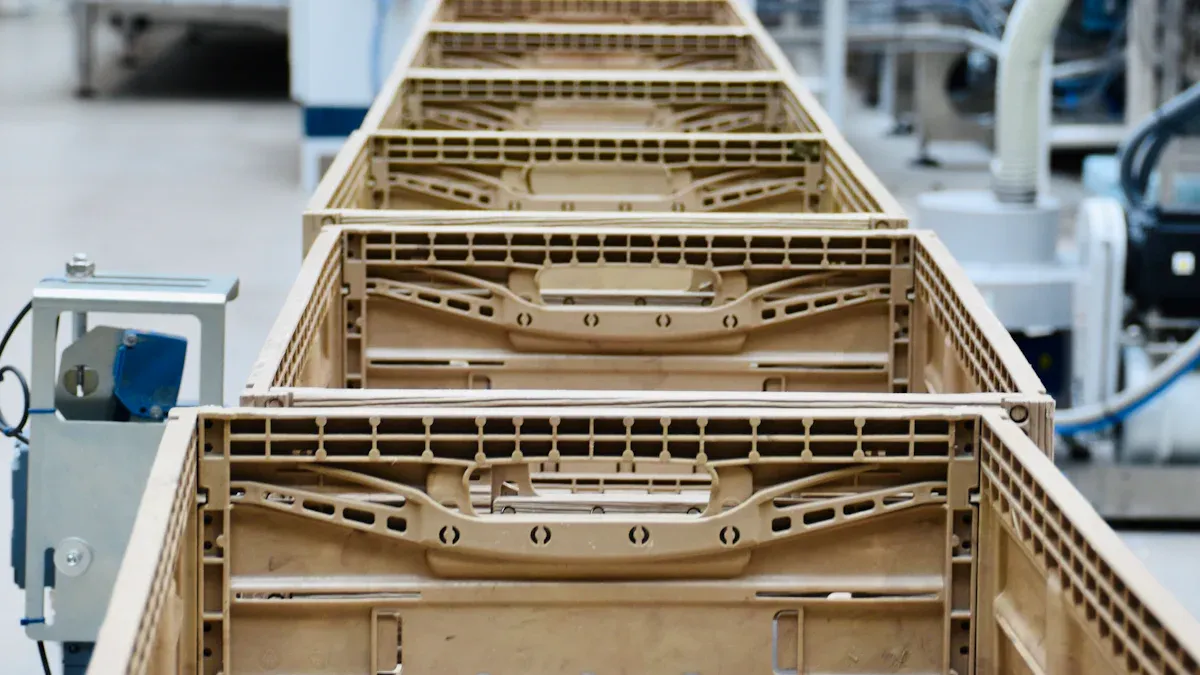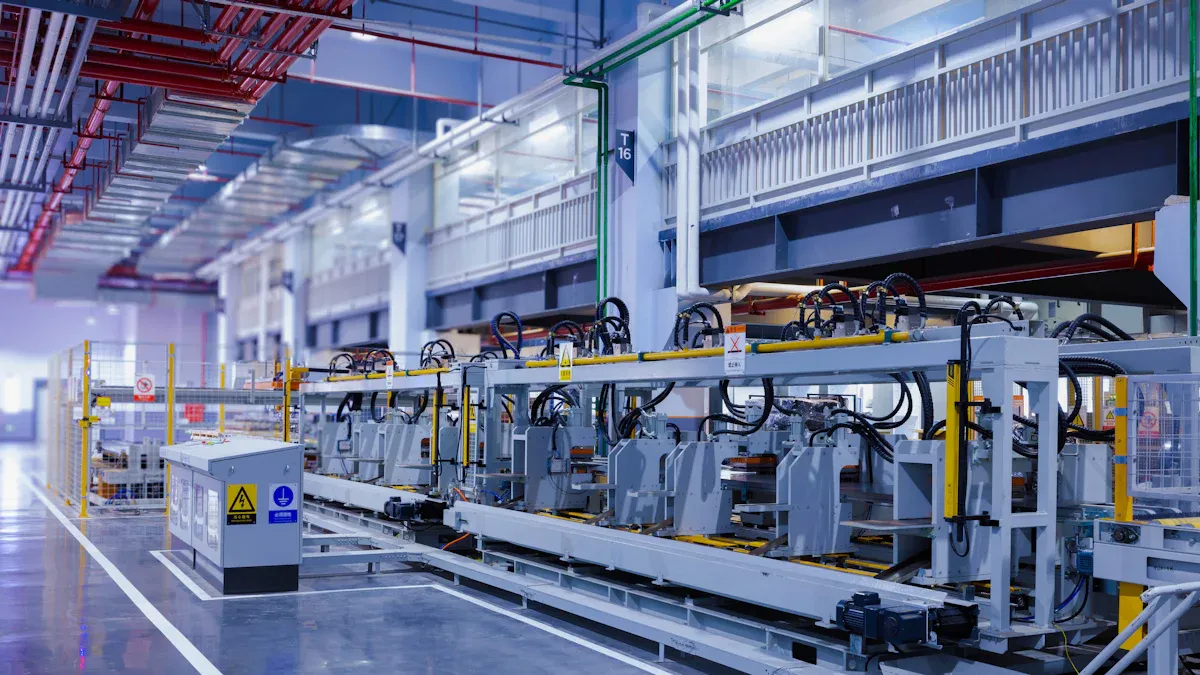
A conveyor in electronics manufacturing moves printed circuit boards (PCBs) efficiently between different stages of assembly. When you use PCB conveyor equipment and SMT peripheral equipment, you help automate the PCBA process and reduce manual handling. This automation links each step, from component placement to inspection, and keeps your production line running smoothly.
- Inspection PCB conveyors let you catch defects early, improving quality.
- Buffer conveyors store PCBs between stages, stopping bottlenecks before they start.
- Turn conveyors redirect PCBs for seamless transitions between stations.
- Integration with SMT equipment maintains a steady workflow and lowers error risks.
By choosing the right PCB conveyor belt or PCB inspection conveyor, you support high-quality output and boost your line’s efficiency. S&M, as one of the dedicated PCB conveyor manufacturers, ensures your SMT PCB conveyor or PCB machine meets strict standards for reliability and precision.
Key Takeaways
- PCB conveyors move circuit boards smoothly between machines, speeding up production and reducing manual work.
- Different conveyor types like belt, inspection, and buffer conveyors help improve quality, prevent delays, and handle boards safely.
- Adjustable and modular conveyors fit various board sizes and production needs, making your assembly line flexible and efficient.
- Integrating conveyors with SMT equipment ensures a steady workflow, reduces errors, and supports automated quality checks.
- Choosing reliable manufacturers like S&M guarantees durable, high-quality conveyors with strong support and compliance with industry standards.
PCB Conveyor Equipment SMT Peripheral Equipment

Definition and Core Function
When you work in electronics manufacturing, you rely on PCB conveyor equipment and SMT peripheral equipment to move printed circuit boards between different machines. This equipment acts as essential peripheral machinery in your SMT line. You use it to handle and transport PCBs from one workstation to another, making sure each board reaches the right place at the right time. Most PCB conveyor equipment and SMT peripheral equipment features a modular design and rugged steel construction. You can adjust the width rails and control the speed to match your production needs. These conveyors comply with SMEMA communication standards, which means you can easily connect them with other SMT equipment.
You will find several types of PCB conveyor equipment and SMT peripheral equipment in a modern assembly line. These include link conveyors, inspection conveyors, dual-lane conveyors, cooling conveyors, and telescopic conveyors. Each type helps you transfer PCBs smoothly and efficiently. For example, a PCB inspection conveyor lets you check boards for defects, while a PCB conveyor belt moves boards quickly between stations. S&M, as one of the leading PCB conveyor manufacturers, designs these machines to fit your specific requirements and ensure reliable performance.
Tip: Using the right SMT peripheral equipment reduces manual handling and keeps your production line running smoothly.
Role in Automated PCBA Production
You use PCB conveyor equipment and SMT peripheral equipment to automate the entire PCB handling process. This automation brings several key benefits to your assembly line:
- You transport PCBs between workstations without manual lifting, which speeds up production.
- You enable automated component placement with pick-and-place machines or robotic arms, improving accuracy.
- You move PCBs through soldering and reflow stations, ensuring consistent solder connections.
- You integrate testing and inspection stations, such as AOI and ICT, to maintain high quality.
- You create buffer zones that temporarily hold PCBs, preventing bottlenecks and keeping the line moving.
- You monitor and synchronize the process in real time with advanced control systems.
- You adjust the system to fit different PCB sizes and production needs, thanks to modularity and flexibility.
| Feature | Description |
|---|---|
| Conveyor Type | Pin Chain, Belt, or Roller |
| Board/Pallet Width | Adjustable to fit various PCB sizes |
| Conveyor Speed | Variable, controlled by PLC or manual input |
| Communication Protocol | SMEMA & IPC-CFX for integration |
| Inspection Capability | Inline AOI, UV, or manual inspection options |
You will notice that pcb conveyor equipment and the SMT peripheral equipment reduce manual labor in your factory. Conveyors, loaders, unloaders, and buffers automate the transfer, loading, unloading, and storage of PCBs. For example, PCB loaders and unloaders use pneumatic push rods to move boards automatically, so you do not need to handle each board by hand. The SMEMA interface allows you to connect all your SMT equipment, ensuring continuous operation and preventing line stoppages. Buffer conveyors store boards temporarily, letting you adjust the pace of production and avoid delays.
- You can customize the size and layout of your PCB conveyor equipment and SMT peripheral equipment to fit your production line.
- These machines are essential in SMT, DIP, and PCBA coating lines, helping you streamline board handling and boost productivity.
When you choose S&M’s SMT PCB conveyor or PCB machine, you get equipment that meets strict quality standards and integrates seamlessly with your other SMT equipment. This approach helps you achieve higher throughput, better quality, and greater efficiency in your electronics manufacturing process.
Types of PCB Conveyors
When you set up an SMT assembly line, you will find several types of PCB conveyor systems. Each type serves a unique purpose and helps you achieve smooth, efficient, and high-quality PCB handling. Understanding these types helps you select the right SMT peripheral equipment for your production needs.
Belt Conveyors
Belt conveyors are the most common type you will encounter in electronics manufacturing. These conveyors use rubber or anti-static PU belts driven by rollers or wheels to move PCBs between stations. You benefit from their smooth and quiet operation, which is essential for high-precision work. Belt conveyors handle a wide range of PCB sizes and thicknesses. You can adjust their speed and width to match your workflow. Many SMT equipment lines use belt conveyors before and after pick-and-place machines, reflow ovens, or inspection stations. Their simple structure and flexibility make them a reliable choice for any PCB machine setup.
Tip: Choose a pcb conveyor belt with ESD protection to prevent electrostatic damage to sensitive components.
Inspection Conveyors
Inspection conveyors, sometimes called PCB inspection conveyors, help you maintain quality control. These conveyors include built-in lighting and inspection stations. You can easily check for defects or misalignments as PCBs move along the line. Inspection conveyors often appear after soldering or component placement, letting you catch issues early and reduce rework.
Buffer Conveyors
Buffer conveyors provide temporary storage for PCBs between SMT equipment. You use them to balance the flow between machines and prevent bottlenecks. Buffer conveyors feature adjustable speed, width, and intelligent queue management. They protect PCBs with anti-static and anti-vibration measures. You can optimize your floor space and keep your production line running smoothly.
| Feature | Benefit |
|---|---|
| Adjustable Speed | Matches production pace |
| ESD Protection | Prevents static damage |
| Real-Time Tracking | Enhances traceability and quality |
Shuttle and Transposition Conveyors
Shuttle conveyors and transposition conveyors move PCBs between parallel lines or different sections of your SMT assembly. You use them when you need to transfer boards across lanes or change their orientation. These conveyors help you maximize space and improve workflow flexibility. S&M, as a trusted PCB conveyor manufacturer, offers shuttle conveyors that ensure precise and reliable board movement.
Specialized Conveyors (Cleaning, Reject, Inverting, Gate, Turn)
Specialized conveyors handle unique tasks in your SMT line:
- Cleaning conveyors remove solder balls and residues, keeping your PCBs clean and reliable.
- Reject conveyors automatically remove defective boards from the line, supporting quality assurance.
- Inverting conveyors flip PCBs so you can process both sides without manual handling.
- Gate conveyors control the flow of PCBs, allowing or stopping movement as needed.
- Turn conveyors change the orientation of PCBs, such as rotating them 90 degrees for downstream processes.
By understanding these types, you can choose the right SMT PCB conveyor or PCB machine for your assembly line. S&M provides a full range of PCB conveyor solutions to help you achieve efficient, high-quality production with your SMT equipment.
Key Features and Benefits
Seamless Integration and Flexibility
You want your SMT assembly line to run smoothly. S&M’s PCB conveyor systems make this possible by supporting seamless integration with other SMT equipment. These conveyors use a standard SMEMA interface, so you can connect them directly to pick-and-place machines, solder paste printers, and inspection systems. You can adjust the speed and width to match different PCB sizes and production needs. The modular design lets you customize the layout, which helps you fit the conveyor into any production space.
Tip: Flexible pcb conveyor belts allow you to switch between different PCB types and sizes quickly. This adaptability means you can handle new products or changes in demand without major disruptions.
| Feature | Description |
|---|---|
| SMEMA Interface Compatibility | Connects easily with other SMT equipment. |
| Adjustable Speed Control | Match the conveyor speed to your process. |
| Modular Design | Customizes length and layout for your line. |
| Robust Construction | Ensures stability and durability. |
Quality Control and Reliability
You need reliable quality in every board you produce. S&M’s PCB inspection conveyors help you catch defects early by integrating with AOI (Automated Optical Inspection) and SPI (Solder Paste Inspection) systems. PLC controllers with touch screens give you real-time monitoring and precise control. Anti-jamming features and safety mechanisms protect both your boards and your team. These conveyors meet CE and ISO standards, so you can trust their long-term performance.
- Automated defect sorting removes faulty PCBs.
- Multi-zone accuracy ensures precise positioning.
- Durable construction supports high-volume production.
Productivity and Efficiency Gains
You can boost your output with automated PCB conveyor equipment. S&M’s smt PCB conveyors support parallel processing and 24/7 operation. This automation reduces manual handling, speeds up production, and minimizes downtime.
| Case Study / Metric | Improvement |
|---|---|
| Consumer Electronics Manufacturer | Capacity up to 85,000 units/day; 65% faster time-to-market |
| Automotive Supplier | First-pass yield improved from 92% to 99.7% |
| Medical Device Startup | Time-to-market cut from 18 to 7 months |
Safety and Automation
You want a safe workplace. S&M’s PCB conveyor systems include emergency stop buttons, safety door locks, and photoelectric sensors. Automation takes over repetitive and hazardous tasks, reducing the risk of workplace accidents. Your team can focus on quality control and process improvement while the conveyor handles the heavy lifting.
- Automatic shutdown protection keeps operations safe.
- Sensors and guards prevent accidents.
- Robust frames and safety features protect both operators and equipment.
With S&M’s pcb conveyor solutions, you gain efficiency, quality, and peace of mind in your SMT assembly line.
Integration in SMT Assembly Lines

Linking with Other SMT Equipment
You rely on PCB conveyors to connect every stage of your SMT assembly line. These conveyors act as the backbone, moving boards between machines like pick-and-place units, solder paste printers, reflow ovens, and inspection stations. You benefit from adjustable speed and width controls, which let you match the conveyor to your specific PCB size and process. SMEMA interface standards ensure that your conveyors integrate seamlessly with loaders, unloaders, and cooling conveyors. This modular approach reduces manual handling and keeps your production line running efficiently. You can expand or reconfigure your line as your needs change, thanks to the flexible design of modern SMT peripheral equipment.
Typical Applications and Layouts
You see PCB conveyors in many roles across the SMT process. You use them for linking, buffering, inspection, and even manual insertion. For example, a PCB inspection conveyor lets you check boards for defects right after soldering. Buffer conveyors help you balance the flow between machines, preventing bottlenecks. You can choose single-lane or dual-rail configurations to match your production volume. Anti-static materials protect sensitive components, while adjustable rails fit different board sizes. You often find these conveyors arranged in straight lines, U-shaped layouts, or modular cells, depending on your factory’s space and workflow.
Tip: Use modular conveyors to adapt quickly to new products or changes in demand.
Selection Considerations
When you select PCB conveyor equipment and SMT peripheral equipment, you need to match the conveyor to your application. Consider these factors:
- Track width adjustment lets you handle various PCB sizes.
- Anti-static workbenches protect your electronic components.
- Docking stations in different sizes help you fit the conveyor to your board type.
- Signal integration with other SMT equipment improves automation and coordination.
- Choose conveyors that support buffering, inspection, and testing for maximum flexibility.
You should also look for reliable PCB conveyor manufacturers like S&M, who provide robust solutions and support for your SMT line. The right choice ensures smooth operation and high-quality results.
Quality Assurance and Service
Compliance and Standards
When you choose S&M’s PCB conveyor solutions, you expect strict compliance with international standards. Leading PCB conveyor manufacturers like S&M use robust Quality Management Systems such as ISO 9001. These systems help you maintain consistent quality across every PCB conveyor, PCB conveyor belt, and SMT PCB conveyor. You see quality principles applied from the design stage to post-sale support.
- S&M follows industry-specific standards like IPC-A-610 for electronic assemblies. This ensures your SMT equipment and SMT peripheral equipment meet high workmanship and reliability requirements.
- Each PCB machine and PCB inspection conveyor undergoes rigorous testing. You benefit from functional, reliability, and environmental tests that minimize defects.
- The company uses ESD-safe materials to protect sensitive PCBs from static damage.
- S&M tracks quality metrics like Parts Per Million (PPM) to monitor and improve defect rates.
Note: S&M’s modular conveyor designs adapt quickly to new products and support cleanroom environments, helping you meet strict contamination control standards.
Support and Customer Satisfaction
You rely on strong after-sales service to keep your production line running. S&M offers a full range of support for your PCB conveyor and SMT equipment.
- Preventive maintenance planning helps you avoid unexpected downtime.
- Dedicated support engineers provide fast troubleshooting and incident management.
- S&M offers tailored support levels with clear response times, so you always know what to expect.
- Equipment relocation assistance ensures smooth moves and quick restarts.
You also receive professional advice before and after your purchase. S&M provides installation, commissioning, and access to global spare parts warehouses. You can join professional training sessions to get the most from your PCB machine and SMT peripheral equipment.
By choosing a reliable partner like S&M, you gain more than just equipment. You build long-term production reliability. S&M’s approach—using layered inspection, real-time monitoring, and transparent communication—helps you maintain high quality and customer satisfaction. This support ensures your PCB conveyor systems deliver consistent results and keep your assembly line competitive.
You now understand what PCB conveyors do in SMT assembly lines. These systems move boards smoothly between machines and help prevent jams or misalignment. When you choose the right conveyor, you support high-speed, accurate, and reliable production.
- Conveyors adjust to different PCB sizes for flexible manufacturing.
- High precision reduces defects and boosts quality.
- Durable designs mean less downtime and maintenance.
- Smart integration with SMT equipment increases efficiency.
Take time to review your production needs. Choose a trusted partner like S&M for quality, service, and long-term reliability.
FAQ
What is a PCB conveyor used for in electronics manufacturing?
A pcb conveyor moves printed circuit boards between different stages of assembly. You use it to link SMT equipment, reduce manual handling, and keep your production line efficient. S&M designs these conveyors for smooth, reliable operation.
What types of SMT peripheral equipment work with PCB conveyors?
You connect PCB conveyors with SMT equipment like pick-and-place machines, reflow ovens, loaders, unloaders, and inspection stations. These devices form a complete assembly line. S&M’s modular designs help you integrate everything easily.
What makes a PCB inspection conveyor different from a regular conveyor?
A pcb inspection conveyor includes lighting and inspection areas. You use it to check for defects as boards move along the line. This helps you catch problems early and maintain high quality in your SMT process.
What should you consider when choosing a PCB conveyor belt?
You should look for ESD protection, adjustable width, and compatibility with your SMT equipment. Reliable PCB conveyor manufacturers like S&M offer belts that fit different PCB machines and production needs.
What sets S&M apart from other PCB conveyor manufacturers?
S&M focuses on quality, compliance, and customer support. You get robust SMT PCB conveyor solutions, fast service, and equipment that meets strict industry standards. S&M helps you achieve efficient, high-quality assembly lines.
